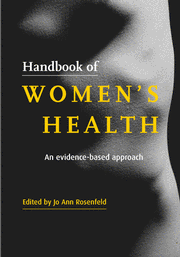Book contents
- Frontmatter
- Contents
- List of contributors
- Common abbreviations used in the text
- Normal blood values in women and during pregnancy
- Introduction
- 1 Singular health care of women
- Preventive care
- Psychosocial health
- Sexuality
- 9 Sexuality and sexual dysfunction through the life cycle
- 10 Contraception
- 11 Infertility and adoption
- 12 Special issues with lesbian patients
- 13 Medical care in pregnancy: common preconception and antepartum issues
- Genitourinary medicine
- Breast disorders
- Psychological disorders
- Common medical problems
- Index
12 - Special issues with lesbian patients
Published online by Cambridge University Press: 28 October 2009
- Frontmatter
- Contents
- List of contributors
- Common abbreviations used in the text
- Normal blood values in women and during pregnancy
- Introduction
- 1 Singular health care of women
- Preventive care
- Psychosocial health
- Sexuality
- 9 Sexuality and sexual dysfunction through the life cycle
- 10 Contraception
- 11 Infertility and adoption
- 12 Special issues with lesbian patients
- 13 Medical care in pregnancy: common preconception and antepartum issues
- Genitourinary medicine
- Breast disorders
- Psychological disorders
- Common medical problems
- Index
Summary
Lesbians comprise approximately 5 percent of the female population and have unique and often neglected health care needs. This chapter focuses on the special health care issues associated with the lesbian population. It reviews existing data, as well as proposing strategies for increasing physician recognition and decreasing alienation of the lesbian patient population.
Introduction
The distinctive nature of lesbian health care needs does not stem from identifiable biological differences or inherent predisposition to disease processes, but from cultural, social, psychological, and economic factors that have served to marginalize this population from mainstream women's health care.
Data regarding lesbian health concerns are scarce. Reasons for the paucity of research are complex.
Another difficulty is the invisible nature of the lesbian population. Many lesbians fear stigmatization and discrimination associated with such identii-cation, a inding consistent with all available research in the area. This fear manifests itself when researchers recruit for studies that demand an unbiased representative lesbian population for comparison with their heterosexual counterparts. Given the illusive nature of the lesbian group, recruitment is diicult, thus rendering many of the research studies extremely biased.
The absence of comprehensive epidemiological studies regarding lesbian health care needs has led to misunderstanding, mistreatment, and dissemination of misinformation regarding appropriate health care maintenance.
- Type
- Chapter
- Information
- Handbook of Women's HealthAn Evidence-Based Approach, pp. 197 - 205Publisher: Cambridge University PressPrint publication year: 2001

